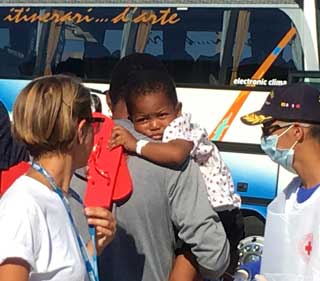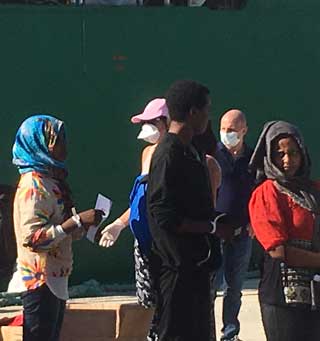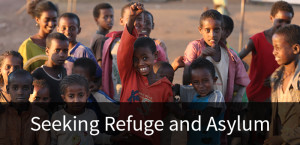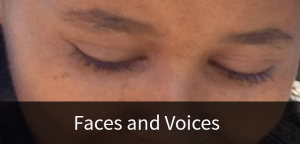Faces and Voices – In Italy
Faces and Voices – In Italy, July 2016

Tortured in Libya, rescued on the Mediterranean
As of July 2016, migrants and refugees from Eritrea and other African countries were continuing to stream into Italy from the Mediterranean, as they had been doing for several years. Many or most had been enslaved and/or tortured in Libya, or they had seen others enslaved, tortured or killed there. From Libya they had been sent out to sea by ruthless smugglers, crammed onto small, unseaworthy craft that were not expected to be able to reach their destinations. Rather, most or all who managed to arrive in Italy had been picked up by large search-and-rescue ships operated either by European naval forces or by private NGOs.
Those who arrived were the fortunate ones; thousands attempting the Mediterranean passage from Africa to Italy had drowned. And unlike many of the Middle East migrants and refugees who had crossed into Greece from Turkey, those crossing from Africa to Italy commonly arrived both brutalized and penniless — having been robbed in Libya of their physical (and often emotional) well-being as well as their last possessions.
Arrival in Sicily
The rescue ships typically ported on southerly Italian islands such as Lampedusa or Sicily. Pictured on this page is a rescue ship operated by Médecins sans Frontiѐres (Doctors without Borders) that members of The America Team observed unloading rescued passengers in Pozzallo, Sicily on July 21. Reportedly the passengers were mostly from Eritrea and Nigeria. At the dock the passengers passed through medical check-points, received packages containing personal care items, were photographed, were handed statements of their rights under European law, and were then loaded onto buses for transport to government reception centers. Upon arrival at the reception centers, the process for evaluating whether they could seek asylum and social support in Italy (or in the alternative whether they should be deported) would begin.
While waiting to debark, a group of Eritrean Christian refugees still on the ship could be seen and heard singing a hymn of salvation.
 But by happenstance, on the same day although in a different port in Sicily, another MSF rescue ship delivered the corpses of 22 people — almost all women — who had died gruesomely on their small craft before the rescue ship arrived. Many of the women were believed to have been raped in Libya. The episode was reported widely in major international news outlets, and an unsettling video of the body bags being unloaded in Sicily appeared on American television on the widely respected PBS NewsHour. That video can be seen here.
But by happenstance, on the same day although in a different port in Sicily, another MSF rescue ship delivered the corpses of 22 people — almost all women — who had died gruesomely on their small craft before the rescue ship arrived. Many of the women were believed to have been raped in Libya. The episode was reported widely in major international news outlets, and an unsettling video of the body bags being unloaded in Sicily appeared on American television on the widely respected PBS NewsHour. That video can be seen here.
At the dock in Pozzallo, The America Team’s observers learned from an NGO staffer who monitors the many rescue ship arrivals in southeastern Sicily that all of the rescue ships are fitted with refrigerators — in anticipation of carrying corpses to shore — and that the typical rescue ship arrives with at least one corpse.
 North through Europe
North through Europe
Despite extraordinary efforts on the part of the Italian government and the considerable goodwill of the Italian people, as of that July the Italian registration, asylum and social service systems were overwhelmed. Migrants and refugees were languishing in dangerous and uncomfortable reception centers, with little hope of being either integrated into Italian society or moved to other European countries for integration there. The combination of the weak Italian economy, the reluctance of some European countries to accept more refugees themselves, and the sheer swiftness and volume of the migrant and refugee influx had conspired to frustrate the efficiency of the Italian systems. Mafia skimming of governmental refugee funds for the shelters was widely alleged. (In April 2017 The Guardian would report on “horrific” levels of child abuse at the shelters; and in May 2017 the Associated Press would report a massive police dragnet of Mafia skimmers.)
Thus many of the arrivals in Italy, including most Eritreans, continued to take matters into their own hands — by “escaping” or migrating “informally” (that is, outside of EU legal procedures) to northern Europe, where they had family, friends, and better prospects for establishing new lives. Typically they traveled through Catania in northeastern Sicily to Messina, then through Rome, then through Milan, then onward to northern Europe.
Many of the cities through which the Eritreans pass are busy commercial centers. Some, especially in summer, are frequented by tourists. The refugees are easily identifiable as new and impoverished African arrivals. Their traumatic histories, however, are not obvious to the eye.
Voices: young survivors in Italy
The interviews appearing on these pages with boys and young men from Eritrea — all of them fresh from their Libyan and Mediterranean ordeals and most on the move northward through Italy — were conducted by The America Team’s observers that July. Their statements are edited for conciseness. These are the circumstances of the interviews:
• Interviews A through D occurred on Via Cupa, an informal, open-air shelter in a small alley in Rome that is staffed by NGOs and that is well known as a way station to Eritreans as far away as Sudan. It is located in a quiet, mixed commercial and residential district, with leafy trees and (on that day) sunny skies. Parts of the alley were piled with camping tents and blankets, but the area was otherwise clean and orderly. Immediately prior to the interviews, The America Team’s observers had witnessed a round-up of all of the shelter’s then visible residents — 50 or 60 in all — by a range of Italian security forces, pursuant to which the residents were taken by bus to a police station for fingerprinting purposes. Many were frightened and a few uncooperative; so after several hours of coaxing by the security forces, some were forced onto the buses. After the buses departed, other residents who had been hiding drifted backed into the alley, and the interviews took place. These interviews, as facilitated by an empathic and adept community worker, were notably candid and graphic.
• Interview E occurred at the Catania (Sicily) bus station, where a group of young boys was passing time on the curb waiting listlessly for friends or relatives from afar to send them travel money. The air was broiling and choked with diesel fumes. The boys were suspicious and barely communicative, but The America Team’s investigators found their brief comments notable.
• Interviews F and G occurred at a government-funded shelter for unaccompanied children on a narrow street in a hill town in Sicily. The interviewed boys seemed relaxed, and their responses were less harrowing than those gathered in Via Cupa; but their level of candor with the interviewers could not be readily assessed.



